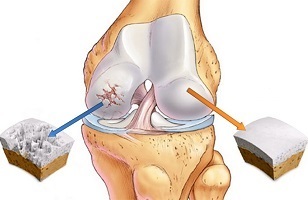
Arthrosis of the knee joint is one of the most common joint diseases, and in terms of the severity of the disease, it is in second place after coxarthrosis.
According to the latest research, the disease strikes one in five adults on earth. In the material, we will tell you what are the symptoms of this disease and how to treat it properly so as not to get complications.
Cause of appearance
Every day, a person's knee joint experiences stress, because while walking, playing sports holds the overall weight. Over time, the cartilage tissue is depleted, causing changes in the joints. For this reason older people may have arthrosis of the knee joint.
In addition, there is a risk group, which includes people:
- overweight;
- suffers from osteoporosis;
- with hereditary disorders;
- elderly;
- works in specific expertise with heavy workload;
- has metabolic disorders;
- lacks micro elements in the body;
- with spinal cord injury;
- athlete.
It should be noted that the disease develops relatively slowly and it is very important to see a doctor on time to get advice if there are major symptoms.
This will prevent the possibility of complications such as disability in the future.
Symptoms of knee arthrosis
To diagnose these diseases, look at the symptoms - they often occur in arthrosis. These include:
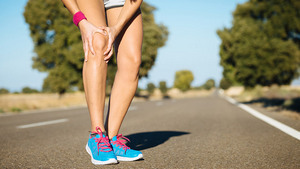
- Pain or discomfort after sleeping (or when trying to get up after sitting for a long time).
- Pain in the knee when standing for a long time.
- While climbing stairs - a burning sensation.
- Night pain or discomfort after exercise.
- Feeling weak and "bent" on the lower limbs.
One of the most important symptoms is pain and sting in the knee area.
At the same time, the disease itself does not appear "suddenly": such sensations can increase for months or years, and at first they will interfere only with the increase of the load, and then the pain will be felteven at rest.
But keep in mind that the symptoms vary depending on the stage of the disease.
Let's take a closer look at each option.
Degree
Arthrosis of this stage is almost asymptomatic, but there are a number of factors that characterize the phase of the disease:
- feeling tired in the limbs;
- decreased movement, which usually occurs after sleep.
If there is pain, it is almost invisible. It is very difficult to diagnose the disease at this stage, therefore, you can not do without X-rays: arthrosis will manifest itself as a small inequality on the surface of tissues and bones.
degree II
At this "stage", the symptoms are milder. Pain can appear even with a slight load on the legs, and over time, such sensations can appear with moderate movements. The discomfort only disappears after a long rest.
In addition, symptoms such as:
- cramps when moving;
- bone changes in joints;
- synovitis;
- inability to bend the leg.
III degrees
A special feature of this stage is severe pain, which is no longer dependent on the load: the joints can interfere even at night if there is no movement.
Mobility is also impaired - a person cannot bend his legs to his knees. Sensitivity to the weather can also be observed.
Diagnostics and principles of further treatment
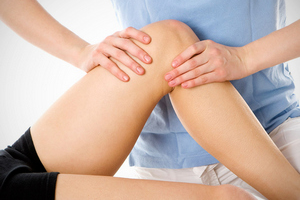
The doctor, after listening to the doctor's advice, will examine the appearance of the knee and evaluate its movement. After that, the patient will be sent for X-rays, and some pictures can be taken during the treatment period, which makes it possible to assess the dynamics of arthrosis development. In some cases, MRI or tomography is prescribed.
If research is needed to accurately determine the underlying cause of arthrosis and separate it from other diseases with similar symptoms.
Treatment usually includes the following:
- Drug therapy.
- Massage and manual therapy.
- Surgical intervention.
- Exercise therapy and other methods of rehabilitation therapy.
The main goals of treatment are as follows:
- pain relief;
- restoration of damaged ligaments and cartilage;
- increased range of motion at the joint.
Massage, physical therapy, and proper nutrition are also important. If you see a doctor late or there is no above method that can help you, surgery will be prescribed: endoprosthesis installation.
Treatment of arthrosis - selection of methods and methods
Currently, there is a group of such drugs prescribed for the treatment of arthrosis at an early stage:
- NSAIDs - non-steroidal anti-inflammatory drugs;
- chondroprotectors;
- medicine ointment;
- compressor.
NSAIDs are intended to relieve pain and inflammation. And only after reducing the pain syndrome, further treatment can be started.
If the use of non-steroidal drugs does not give any results, especially if the disease is only persistent, the doctor will usually prescribe hormone medication.
However, keep in mind that due to some side effects, such drugs are only prescribed during the course of the disease - if fluid accumulates in the articular part. The solution is injected no more than 1 time in 10 days.
The only group of agents that directly affect the cause of arthrosis are chondroprotectors. They are very effective in the early stages.
Also in the early stages, hyaluronic acid, which is injected into the joints, is very effective. This procedure is not the cheapest, but helps sweep the cartilage surface.
When arthrosis is detected, the ointment is also prescribed - it also reduces pain and eliminates inflammation.
How traditional medicine can help
It is immediately said that you can not use traditional medicine alone - can only be used as an adjunct to medical treatment.
Let's look at some things that can help with knee arthrosis:
Dandelion flowers
You only need to eat 5 dandelions per day, be sure to rinse them with boiled water. You can also make tincture: take 5 bottles of dark glass, fill 50% with flowers, fill the container with cologne three times to the neck. Insist for a month, then wipe the knee with an infusion.
Hitting
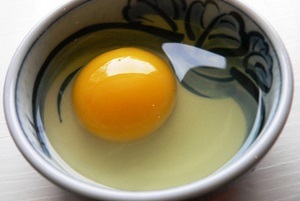
This is a compound that must be applied to the knee joint regularly.
It is very easy to make such a composition: take the egg yolk, mix with 1 tbsp. l. turpentine, add 1 tsp. apple cider vinegar. All ingredients must be mixed and left overnight.
Apply to your knees every night, and cover with a fleece scarf.
Moreover, it is very important to wash the mixture used in the morning. To relieve symptoms, you should use this method for 2-3 weeks.
Burdock
According to folklore, you need to attach 3-4 large burdock leaves to a sore knee and wrap it with a bandage. Repeat this manipulation for at least a week to relieve pain. And to enhance the effect, you need to lubricate the joints with cinquefoil oil.
Celandine Juice
Soak a piece of cloth with juice and place it on the affected knee. After an hour, comb with vegetable oil. Repeat the procedure for a week.
Harpagophytum Root
Take 2 tbsp. l. means, pour into a thermos, pour 1 liter of boiling water, leave for two hours. Take at least 3 glasses a day warm.
Choosing a knee bandage for arthrosis
Often, for arthrosis of the knee joint, it is recommended to wear a special knee bandage, which both reduces discomfort and has a therapeutic effect. Usually, when used for a short period of time, you will see improvements such as:
- the inflammatory process decreases;
- swelling disappears;
- pain relief;
- reduces pressure on joints;
- stable musculoskeletal system function.
It is very important to choose the right model that will be effective while wearing. To do this, let's first learn the types of knee pads:
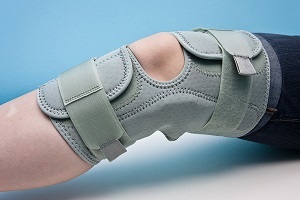
- Open.Important for those who experience pain after suffering an injury or mild pain.
- Elastic productswith hardeners. This type of knee pad is more suitable for those who experience pain when squatting, climbing or descending stairs.
- Openknee pads with adjustable tension. Such products are very suitable after surgery.
- Closed type- it is used if the source of the pain is unclear, i. e. not concentrated in a particular place. Allows you to reduce pressure on the joints.
- Magnetic appearanceKnee pads are characterized by the presence of special magnets, as there is a warming effect, blood circulation is improved.
- Hired.Considered a universal choice. Used to reduce pain after injury, arthrosis.
In addition to the type, you must also take into account the material from which the knee is made. So, such items can be made from:
- Animal fur.This product warms, absorbs moisture, reduces inflammation and improves blood circulation in tissues.
- Polyester.Knee pads made of this artificial fabric are very comfortable, reliable, but not hot and quite expensive.
- Cotton. Easy to use, waterproof. True, there are also disadvantages: lack of elasticity and fragility of use.
- Nylon.Knee pads made of this material are considered the most durable, suitable for the body. But there are also disadvantages - these are artificial materials.
- Neoprena.Although it is a man-made fabric, this material is elastic and has a warming effect. There are also disadvantages - wearing such knee protection can cause allergies.
But it is important not only to choose the right knee pads, but also to use them. Doctors provide some important recommendations to follow:
- you may not wear it for more than three hours a day;
- the duration of application depends on the degree of arthrosis - the doctor will tell you in more detail about this;
- if you have allergies, you should immediately see a doctor who will give you another bandage;
- impossible agent pressing hard on joints;
- wash your knee protection by hand, water temperature should not exceed +40 degrees.
In conclusion, it should be said that one should not neglect a healthy lifestyle - in this case, the body will function as it should. If you feel pain in the joints, you should see a doctor immediately to make a correct diagnosis.

























